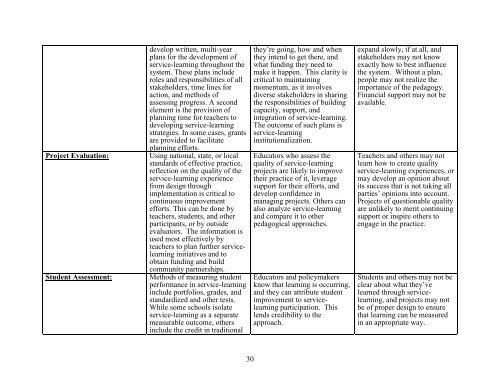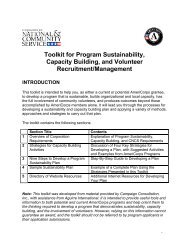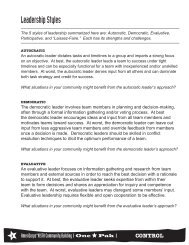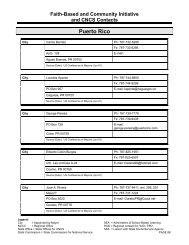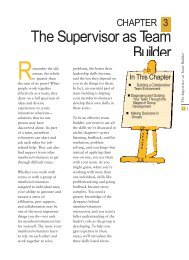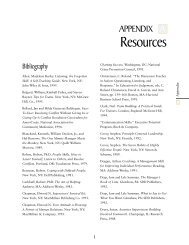MAKE IT LAST FOREVER: THE ... - National Service Resource Center
MAKE IT LAST FOREVER: THE ... - National Service Resource Center
MAKE IT LAST FOREVER: THE ... - National Service Resource Center
You also want an ePaper? Increase the reach of your titles
YUMPU automatically turns print PDFs into web optimized ePapers that Google loves.
develop written, multi-year<br />
plans for the development of<br />
service-learning throughout the<br />
system. These plans include<br />
roles and responsibilities of all<br />
stakeholders, time lines for<br />
action, and methods of<br />
assessing progress. A second<br />
element is the provision of<br />
planning time for teachers to<br />
developing service-learning<br />
strategies. In some cases, grants<br />
are provided to facilitate<br />
planning efforts.<br />
Project Evaluation: Using national, state, or local<br />
standards of effective practice,<br />
reflection on the quality of the<br />
service-learning experience<br />
from design through<br />
implementation is critical to<br />
continuous improvement<br />
efforts. This can be done by<br />
teachers, students, and other<br />
participants, or by outside<br />
evaluators. The information is<br />
used most effectively by<br />
teachers to plan further servicelearning<br />
initiatives and to<br />
obtain funding and build<br />
community partnerships.<br />
Student Assessment: Methods of measuring student<br />
performance in service-learning<br />
include portfolios, grades, and<br />
standardized and other tests.<br />
While some schools isolate<br />
service-learning as a separate<br />
measurable outcome, others<br />
include the credit in traditional<br />
30<br />
they’re going, how and when<br />
they intend to get there, and<br />
what funding they need to<br />
make it happen. This clarity is<br />
critical to maintaining<br />
momentum, as it involves<br />
diverse stakeholders in sharing<br />
the responsibilities of building<br />
capacity, support, and<br />
integration of service-learning.<br />
The outcome of such plans is<br />
service-learning<br />
institutionalization.<br />
Educators who assess the<br />
quality of service-learning<br />
projects are likely to improve<br />
their practice of it, leverage<br />
support for their efforts, and<br />
develop confidence in<br />
managing projects. Others can<br />
also analyze service-learning<br />
and compare it to other<br />
pedagogical approaches.<br />
Educators and policymakers<br />
know that learning is occurring,<br />
and they can attribute student<br />
improvement to servicelearning<br />
participation. This<br />
lends credibility to the<br />
approach.<br />
expand slowly, if at all, and<br />
stakeholders may not know<br />
exactly how to best influence<br />
the system. Without a plan,<br />
people may not realize the<br />
importance of the pedagogy.<br />
Financial support may not be<br />
available.<br />
Teachers and others may not<br />
learn how to create quality<br />
service-learning experiences, or<br />
may develop an opinion about<br />
its success that is not taking all<br />
parties’ opinions into account.<br />
Projects of questionable quality<br />
are unlikely to merit continuing<br />
support or inspire others to<br />
engage in the practice.<br />
Students and others may not be<br />
clear about what they’ve<br />
learned through servicelearning,<br />
and projects may not<br />
be of proper design to ensure<br />
that learning can be measured<br />
in an appropriate way.


